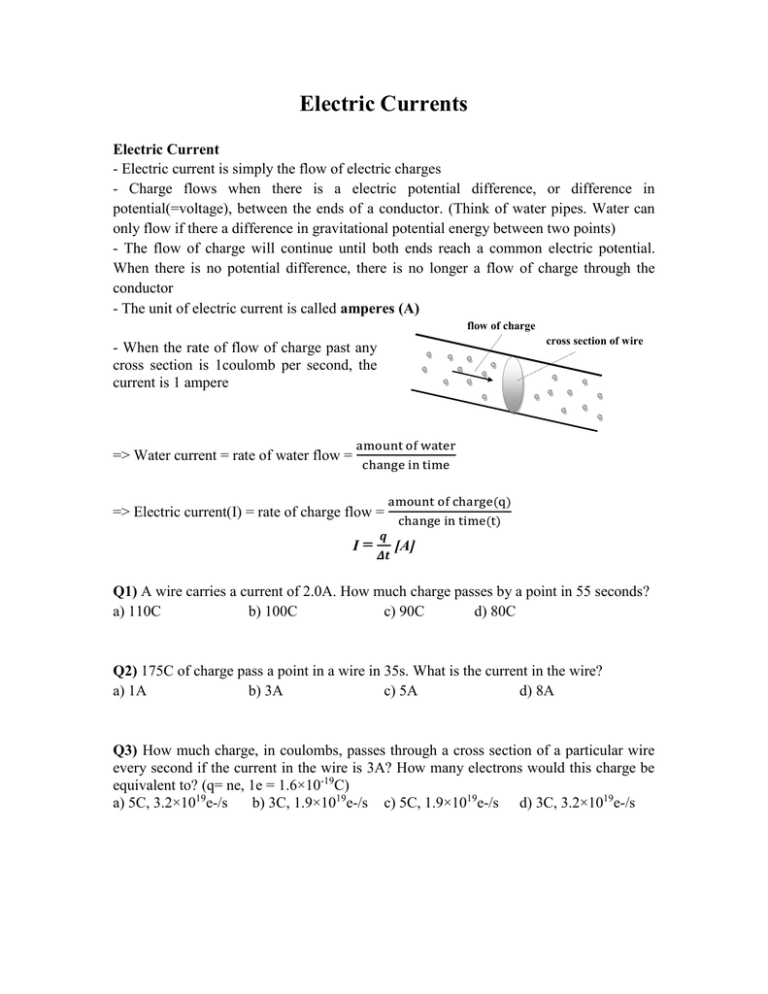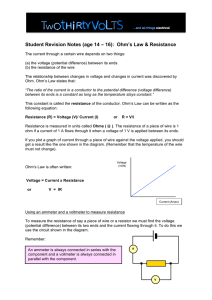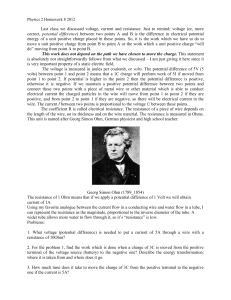Electric Currents
advertisement

Electric Currents Electric Current - Electric current is simply the flow of electric charges - Charge flows when there is a electric potential difference, or difference in potential(=voltage), between the ends of a conductor. (Think of water pipes. Water can only flow if there a difference in gravitational potential energy between two points) - The flow of charge will continue until both ends reach a common electric potential. When there is no potential difference, there is no longer a flow of charge through the conductor - The unit of electric current is called amperes (A) flow of charge cross section of wire - When the rate of flow of charge past any cross section is 1coulomb per second, the current is 1 ampere => Water current = rate of water flow = amount of water change in time => Electric current(I) = rate of charge flow = I= amount of charge(q) 𝒒 𝜟𝒕 change in time(t) [A] Q1) A wire carries a current of 2.0A. How much charge passes by a point in 55 seconds? a) 110C b) 100C c) 90C d) 80C Q2) 175C of charge pass a point in a wire in 35s. What is the current in the wire? a) 1A b) 3A c) 5A d) 8A Q3) How much charge, in coulombs, passes through a cross section of a particular wire every second if the current in the wire is 3A? How many electrons would this charge be equivalent to? (q= ne, 1e = 1.6×10-19C) a) 5C, 3.2×1019e-/s b) 3C, 1.9×1019e-/s c) 5C, 1.9×1019e-/s d) 3C, 3.2×1019e-/s Voltage Sources and Resistance i) Voltage Sources - Charges do not flow unless there is a potential difference(=Voltage) - A battery is one example of a voltage source. - A battery has two terminals. One terminal is marked ‘+’ and the other is marked ‘-’. - If you connect a wire between the negative and positive terminals, the electrons will flow from the negative to the positive terminal as fast as they can (and wear out the battery very quickly -- this also tends to be dangerous, especially with large batteries, so it is not something you want to be doing). ii) Resistance When charges flow, it has kinetic energy. By placing a resistor, like a light bulb, the resistor converts some of the kinetic energy of the charges in motion into heat and light. In physics, resistance is defined as the opposition to the flow of charges through a conductor. When rubbing your hands together, the friction converts some of the kinetic energy of motion into heat energy. The filament of the bulb does the same thing, converting the electrical energy into heat and light. The electrical resistance(R) of a circuit component or device is defined as the ratio of the voltage(V) applied to the electric current(I) which flows through it: R= 𝑉 𝐼 [Ω] The unit for resistance is called ohm [Ω] Ohm’s Law *~ important! If the resistance is constant over a considerable range of voltage, then the current in a circuit is directly proportional to the voltage across the circuit, and is inversely proportional to the resistance of the circuit current(I) = 𝐯𝐨𝐥𝐭𝐚𝐠𝐞(𝐕) 𝐫𝐞𝐬𝐢𝐬𝐭𝐚𝐧𝐜𝐞(𝐑) I= ; Ohm’s law 𝑽 𝑹 *~Ohm’s law is not universal. Materials that obey Ohm’s law are mostly conductors. Semiconductors do not obey Ohm’s law~* I= 𝑽 𝑹 Q4) Find the current through a bulb that has a resistance of 3Ω and a potential difference of 9V across it. a) 12A b) 9A c) 6A d) 3A Q5) A component has a potential difference of 3V across it and a current of 2A through it. Calculate its resistance. a) 1.5Ω b) 3.0Ω c) 4.5Ω d) 6.0Ω Q6) Find the current through a 3Ω resistor with a voltage of 1.5V a) 0.5A b) 2.5A c) 5.5A d) 8.5A - The main cause of electric shock in the human body is current, not the voltage. - The resistance of your body depends on its condition and ranges from 100Ω if you are soaked with salt water to about 500000Ω if your skin is very dry. - If you touched the two electrodes of a battery with dry fingers, the resistance your body would normally offer to the flow of charge would about 100000Ω. - You usually would not feel 12V, and 24V would just barely tingle. If your skin were moist, 24V could be quite uncomfortable. Effect of Various Electric Currents on the Body Current in Amperes Effect 0.001 Can be felt 0.005 Painful 0.010 Involuntary muscle contractions 0.015 Loss of muscle control 0.070 If through heart = I= 𝑽 𝑹 Q7) If the resistance of your body were 100000Ω, what would be the current in your body when you touched the terminals of a 12V battery? Q8) If your skin were very moist so that your resistance was only 1000Ω, and you touched the terminals of a 24V battery, how much current would you draw? Q9) A student performed an experiment in which the potential difference V between the ends of a long straight wire was varied. The current I in the wire was measured at each value of the potential difference with an ammeter and the results of the experiment are shown in the table below. Trial 1 2 3 4 5 6 7 8 V (volts) 5 10 15 20 25 30 35 40 I (amperes) 0.25 0.50 0.75 1.00 1.50 1.65 1.55 1.53 Which one of the following statements is the best conclusion based on the data? Justify your answer by plotting V vs I graph below~! Remember to connect the dots also!! (a) The resistance of the wire is 20Ω. (b) The wire does not obey Ohm’s law. (c) The wire obeys Ohm’s law over the range of potential differences between 5 and 30V (d) The wire obeys Ohm’s law over the range of potential differences between 5 and 20V V 40 30 20 10 0.25 0.50 0.75 1.00 1.25 1.50 1.75 2.00 I




